Music Theory Basics for Beginners: Guitar & Piano Made Easy
Category: Music Theory
Get Started with Music Theory Basics for Beginners
If you've ever wanted to play your favorite songs on guitar or piano but felt overwhelmed by all the music jargon and notes, you're in the right place. Learning music theory can seem daunting at first, especially without a clear, straightforward guide tailored for beginners. Whether you picked up your instrument yesterday or several weeks ago, you might be struggling to connect the dots between what you see on the staff and what you want to play. That confusion often leads to frustration and stalled progress.
This blog post is designed specifically for beginner musicians and music enthusiasts like you who need a simple, no-fluff introduction to music theory, focusing on practical applications for guitar and piano. Instead of drowning in complex theory, we break down essential concepts into manageable, understandable sections that will help you start reading notes, understand rhythms, and build chords step-by-step.
You'll learn how music theory directly relates to your instrument, and we include clear examples and mini tutorials for guitar and piano along the way. By the end, you won’t just know the theory—you’ll feel confident applying it to play music faster and with more enjoyment. Keep reading to transform your music practice and make theory a helpful tool, not a barrier.
- Get Started with Music Theory Basics for Beginners
- Understanding the Musical Alphabet: Notes and Their Names
- Reading Musical Notation Basics: Staff, Clefs, and Note Values
- Rhythm and Time Signatures: Keeping Your Beat
- Scales Explained: Major and Minor Foundations
- Intervals: Building Blocks of Melody and Harmony
- Chords 101: How to Build and Play Basic Chords
- The Circle of Fifths: Your Map to Keys and Chord Progressions
- Putting Theory into Practice: Simple Songs and Exercises for Guitar and Piano
- Tips for Effective Practice: How to Make Music Theory Stick
- Recommended Resources and Next Steps: Apps, Books, and Online Courses to Deepen Your Music Theory Knowledge
Understanding the Musical Alphabet: Notes and Their Names
To start playing guitar or piano with confidence, you first need to understand the musical alphabet—the foundation of all music theory. Unlike the 26-letter alphabet you’re used to, the musical alphabet consists of only 12 unique notes that repeat in cycles. These notes form the building blocks of melodies, chords, and scales across Western music.
The 12 Notes in Western Music
The musical alphabet follows this sequence of notes:
A, A♯/B♭, B, C, C♯/D♭, D, D♯/E♭, E, F, F♯/G♭, G, G♯/A♭
Here’s what you need to know:
- Natural notes are the basic letter names — A, B, C, D, E, F, and G.
- Sharps (#) raise a natural note by a half step.
- Flats (b) lower a natural note by a half step.
On a piano, these 12 notes repeat every octave. The white keys represent natural notes, while the black keys represent sharps and flats. For guitar players, each fret on a string moves the note up by a half step, so the 12 notes repeat every 12 frets.
Examples on Piano and Guitar Fretboard
- On piano, start at middle C. The next black key to the right is C♯ (or D♭), then D (white key), then D♯ (or E♭), and so on. This pattern continues across all octaves.
- On guitar, the open 6th string is an E note. Fret 1 is F, fret 2 is F♯ (or G♭), fret 3 is G, and the pattern continues until fret 12, which brings you back to E, one octave higher.
Mastering this musical alphabet helps you read sheet music, understand fretboard note locations, and improve your ability to improvise and compose. As you progress, you’ll see how these 12 notes interact to create scales, chords, and melodies—fundamental knowledge for any beginner guitarist or pianist.

Image courtesy of Pixabay
Reading Musical Notation Basics: Staff, Clefs, and Note Values
To bring your guitar and piano skills to the next level, learning to read musical notation is essential. Reading sheet music allows you to play songs accurately, understand rhythms, and communicate with other musicians. Let’s break down the basics: the musical staff, the two main clefs relevant for guitar and piano, and the different note values that tell you how long to hold each sound.
The Musical Staff: Your Reading Map
Music is written on a staff, which consists of five horizontal lines and four spaces. Each line and space corresponds to a specific musical note. Notes are placed on these lines or in the spaces between them, depending on their pitch. The higher the note on the staff, the higher the pitch you play.
Clefs: Understanding Treble and Bass
Since the staff can represent many notes, clefs are symbols placed at the beginning of the staff to indicate which notes correspond to which lines and spaces.
- Treble Clef (G Clef): Most common in guitar music and the right hand for piano. It circles around the second line, which represents the note G above middle C.
- Bass Clef (F Clef): Used for the lower range in piano music, especially the left hand. It marks the fourth line as the F below middle C.
Understanding these clefs is crucial because guitar music almost always uses the treble clef, while piano music spans both. This allows pianists to read both high and low notes simultaneously.
Note Values: Timing in Music
Musical notes have different shapes that indicate their duration, or how long you hold each note. Here are the most common note values you’ll encounter:
- Whole Note (semibreve): A hollow oval with no stem; lasts 4 beats.
- Half Note (minim): Hollow oval with a stem; lasts 2 beats.
- Quarter Note (crotchet): Filled oval with a stem; lasts 1 beat.
- Eighth Note (quaver): Filled oval with a stem and one flag; lasts half a beat.
- Sixteenth Note (semiquaver): Filled oval with a stem and two flags; lasts a quarter of a beat.
For guitar and piano players, mastering these durations helps you play rhythms accurately and stay in time. When you see a sequence of eighth or sixteenth notes, you know to play those notes faster and more in a row, while whole and half notes give you longer, sustained sounds.
Once you’re comfortable with the staff layout, clefs, and note values, you’ll find reading your favorite songs much easier. This foundation will allow you to decode sheet music, translate it directly to your instrument, and improve your overall timing and rhythm dramatically.
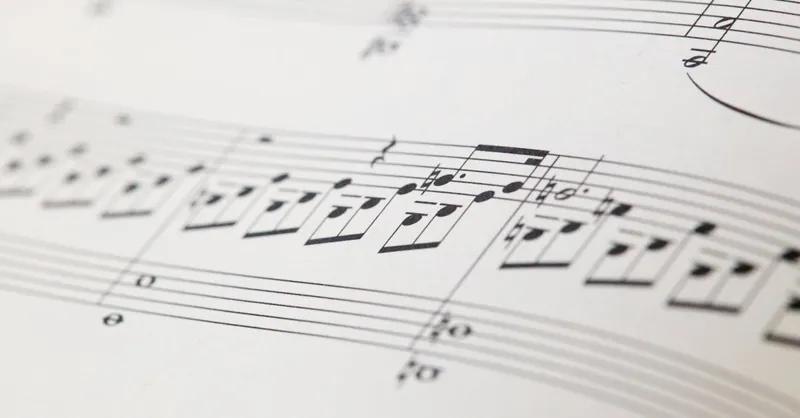
Image courtesy of César Guillotel
Rhythm and Time Signatures: Keeping Your Beat
Now that you understand the basics of notes and how to read them, it’s time to dive into the heart of music: rhythm and time signatures. Rhythm is what makes music move and groove, giving it a pulse that you can feel and play along with—whether on guitar or piano. Without rhythm, melodies would be just floating sounds without structure. Learning to count and understand rhythm will help you play music smoothly and in sync with other musicians.
What Is Rhythm?
Rhythm refers to the timing of sounds and silences in music. It’s how long notes last, when they start, and when they stop. Notes and rests (silences) combine to create patterns that repeat over time. For beginners on guitar or piano, recognizing these patterns will allow you to play chords, melodies, and accompaniments with a steady beat.
Understanding Time Signatures: The Music’s Pulse
A time signature tells you how music is counted and grouped, much like how you count beats in a dance. It appears at the beginning of a piece of sheet music as two numbers stacked vertically, like 4/4 or 3/4.
- The top number indicates how many beats are in each measure (or bar).
- The bottom number shows what type of note gets one beat (4 means a quarter note gets one beat, 3 means a dotted half note, etc.).
The most common time signatures you’ll encounter are:
- 4/4 Time (Common Time): Four beats per measure; quarter note gets one beat. This is the standard "pop" or "rock" beat, perfect for guitar strumming patterns and piano accompaniments.
- 3/4 Time: Three beats per measure; quarter note gets one beat. This creates a waltz or dance feel, often softer and flowing.
Note and Rest Symbols: Silence Matters Too
Just as important as playing notes is knowing when to pause. Rests are symbols that tell you to be silent for a specific duration, matching note values.
| Symbol | Duration | Explanation |
|---|---|---|
| Whole Rest | 4 beats | Silence for a whole measure |
| Half Rest | 2 beats | Silence for half a measure |
| Quarter Rest | 1 beat | Silence for one beat |
| Eighth Rest | 1/2 beat | Silence for half a beat |
| Sixteenth Rest | 1/4 beat | Silence for a quarter of a beat |
Mastering rests is just as critical as notes because it keeps your playing clean and rhythmically precise.
How to Count Rhythm for Guitar and Piano Beginners
Counting rhythm aloud or in your head helps you stay synchronized with the music. For example, in 4/4 time, count like this:
- 1 2 3 4 for four quarter notes, each one played on a count.
- For eighth notes, count “1 & 2 & 3 & 4 &,” playing notes on numbers and the “&” in between, which represent half-beats.
When practicing guitar, strum or pluck strings on these counts; for piano, press keys accordingly. Using a metronome can be very helpful to keep a consistent tempo.
Practical Tips
- Practice clapping or tapping the rhythm before playing your instrument.
- Start slow with simple rhythms, then gradually increase speed.
- Focus on feeling the beat and internalizing the time signature.
Understanding rhythm and time signatures is essential for expressing musical ideas clearly and confidently on both guitar and piano. With steady practice, reading rhythmic notation will become second nature, helping your playing sound professional and polished.
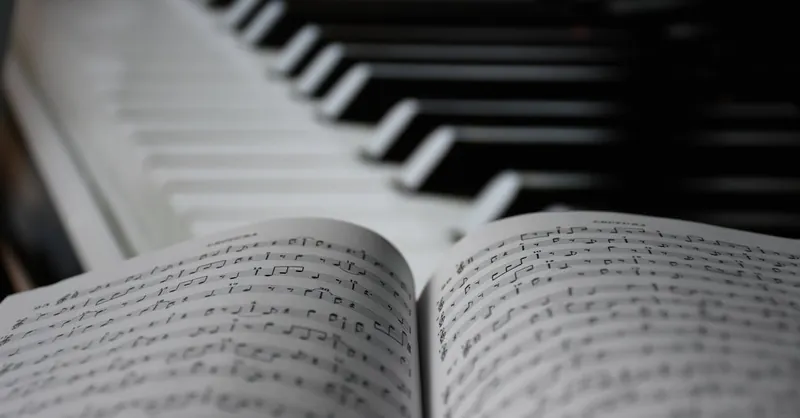
Image courtesy of Sebastian Rivera
Scales Explained: Major and Minor Foundations
Understanding scales is a crucial step for every beginner learning music theory because scales form the foundation for melodies and chords on both guitar and piano. The two most important scales to start with are the major scale and the natural minor scale. These scales not only define the mood and tone of music but also guide you in creating solos, improvisations, and harmonies.
The Major Scale: Your Starting Point for Melody and Harmony
The major scale is known for its bright, happy sound and is the most commonly used scale in Western music. It follows a specific pattern of whole steps (two frets/keys) and half steps (one fret/key):
Major Scale Pattern:
- Whole step
- Whole step
- Half step
- Whole step
- Whole step
- Whole step
- Half step
For example, the C major scale contains the notes:
C - D - E - F - G - A - B - C
No sharps or flats here, which makes it a great scale for beginners on both piano and guitar.
Playing the Major Scale on Piano and Guitar
- Piano: Start with your thumb on C (middle C), then play each white key ascending according to the major scale pattern. Use your right hand fingers: thumb (1), index (2), middle (3), thumb (1), index (2), middle (3), ring finger (4), pinky (5).
- Guitar: Play the C major scale starting on the 3rd fret of the 5th string (note C). Use your index finger for the 3rd fret, middle finger for the 5th fret, and follow standard scale fingering patterns moving across strings for smooth transitions.
The Natural Minor Scale: Exploring a More Melancholic Sound
The natural minor scale gives music a sadder, more introspective feel. It’s derived from the major scale but with a different pattern of whole and half steps:
Natural Minor Scale Pattern:
- Whole step
- Half step
- Whole step
- Whole step
- Half step
- Whole step
- Whole step
For example, the A natural minor scale notes are:
A - B - C - D - E - F - G - A
These notes share the same pitches as C major but start and resolve on A, producing that minor tonality.
Playing the Natural Minor Scale on Piano and Guitar
- Piano: Use your right hand finger numbers 1-2-3-1-2-3-4-5 starting on A (the white key just below middle C).
- Guitar: Start on the 5th fret of the 6th string for the A minor scale. Use a typical natural minor scale fingering shape and practice moving through the notes smoothly.
Why Learn Scales? The Building Blocks of Music
Scales are essential because:
- They form the basis of melodies you hear and play.
- They help construct chords since chords are built from scale notes.
- Understanding scales improves your ability to improvise and compose on piano and guitar.
- They make it easier to identify keys and chord progressions, which is critical for learning songs quickly.
By practicing these scales regularly, you’ll develop finger strength, muscle memory, and a deeper understanding of how music works. Over time, you’ll notice your ability to create musical ideas flowing naturally on both instruments.
Quick Scale Practice Tips for Beginners
- Start slow, playing each note clearly and evenly.
- Use a metronome to keep a steady tempo.
- Practice scales ascending and descending.
- Focus on smooth finger transitions and consistent tone.
- Incorporate scales into simple melodies or exercises to make practice more enjoyable and musical.
Mastering the major and natural minor scales is your key to unlocking the vast world of music theory with practical applications on guitar and piano. Once you're comfortable with these scales, moving on to other scale types and modes becomes much easier and more meaningful.
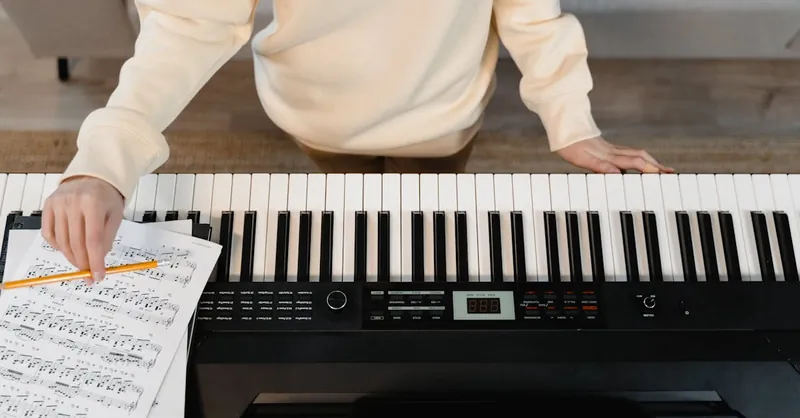
Image courtesy of Tima Miroshnichenko
Intervals: Building Blocks of Melody and Harmony
At the heart of music theory lies the concept of intervals—the distance between two notes. Understanding intervals is essential for both guitar and piano players because they form the foundation of melody, harmony, chords, and scales. Recognizing intervals by ear and on your instrument allows you to identify relationships between notes, build chords, and create musical phrases that sound cohesive and expressive.
What Is an Interval?
An interval refers to the number of steps between two pitches. These steps can be measured in half steps and whole steps on piano (keys) or frets on guitar. Intervals are named based on the number of letter names they span, including the starting and ending notes. For example, from C to E is a third because it covers C, D, and E—three letter names.
Common Interval Names and Their Sounds
Here are some of the most important intervals every beginner should know, along with their characteristic sound and how to find them on guitar and piano:
- Unison (Perfect Unison): Same note played twice.
- Sound: Identical tones.
- Piano: Same key played twice.
-
Guitar: Same fret, different string or same string open and fretted.
-
Minor Second (Half Step): One fret/key apart.
- Sound: Very dissonant, tense (e.g., C to C♯).
- Piano: Adjacent keys, white to black or black to white, no keys between.
-
Guitar: One fret difference.
-
Major Second (Whole Step): Two frets/keys apart.
- Sound: Like a happy "step" in a scale (e.g., C to D).
- Piano: One key between notes (white to white with black in between).
-
Guitar: Two frets apart.
-
Minor Third: Three half steps.
- Sound: Sad or bluesy tone.
-
Example: C to E♭.
-
Major Third: Four half steps.
- Sound: Bright, happy tone.
-
Example: C to E.
-
Perfect Fourth: Five half steps.
- Sound: Open and stable, often used in melodies.
-
Example: C to F.
-
Perfect Fifth: Seven half steps.
- Sound: Powerful and consonant; very common in chords.
-
Example: C to G.
-
Octave: Twelve half steps, same note name but higher or lower pitch.
- Sound: Identical note at a higher or lower pitch.
Recognizing Intervals by Ear and on Your Instrument
Training your ear to identify intervals is key for improvisation, transcribing music, and understanding how melodies move. Start by singing intervals or playing them on your instrument and noticing how each interval feels and sounds different. Here’s a simple way to practice:
- Play or sing two notes one after the other.
- Name the interval (e.g., major third, perfect fifth).
- Compare the sound to famous songs that start with that interval (for example, the first two notes of "Here Comes the Bride" are a perfect fourth).
Practical Tips for Guitar and Piano
- On Piano: Because all 12 notes are laid out linearly, intervals are counted by moving right (ascending) or left (descending) along the keys. Try playing and naming intervals starting from middle C.
- On Guitar: Intervals can be found by counting frets up from a root note on the same string, or by moving across strings using familiar patterns. Learning common interval shapes helps in building chords and solo patterns quickly.
Mastering intervals sharpens your understanding of how music is built and drastically improves your ability to play expressively and intuitively on guitar and piano. As intervals are the building blocks for chords and scales, they provide a roadmap to unlocking the full potential of your instrument.
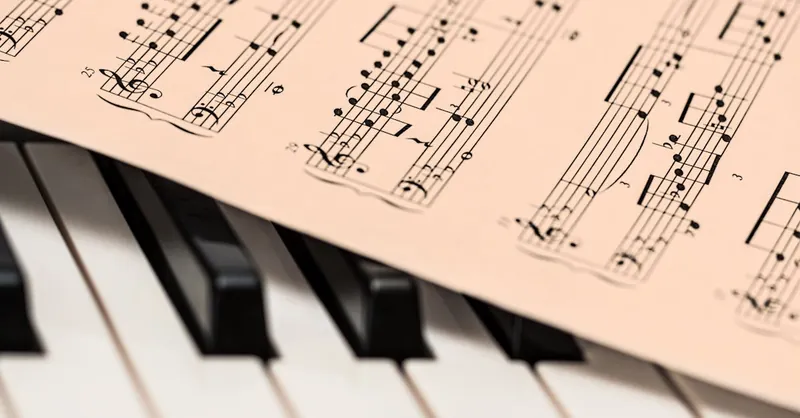
Image courtesy of Pixabay
Chords 101: How to Build and Play Basic Chords
Chords are the heart of playing guitar and piano—they provide harmony, support melodies, and help you play your favorite songs. Understanding how to build and play basic chords is an essential step for any beginner. At their simplest, chords are just a combination of three or more notes played together, with triads being the foundational type of chord you’ll want to master first.
What Are Triads?
A triad is a three-note chord constructed using a specific formula based on intervals from a root note. The three notes in a triad include:
- The root (the note the chord is named after)
- The third (which determines if the chord is major or minor)
- The fifth (which adds fullness and stability)
These three notes create the basic structure for most chords you’ll encounter.
Chord Formulas: Building Major, Minor, and Seventh Chords
To understand how chords differ, let’s look at the formulas based on intervals, counted in half steps:
| Chord Type | Formula (Intervals from Root) | Sound Characteristic |
|---|---|---|
| Major | Root + Major Third (4 half steps) + Perfect Fifth (7 half steps) | Bright, happy, stable |
| Minor | Root + Minor Third (3 half steps) + Perfect Fifth (7 half steps) | Sad, melancholic, softer |
| Dominant 7th | Root + Major Third + Perfect Fifth + Minor Seventh (10 half steps) | Bluesy, tense, and full |
For example:
- C Major chord: C (root), E (major third), G (perfect fifth)
- A Minor chord: A (root), C (minor third), E (perfect fifth)
- G7 chord: G (root), B (major third), D (perfect fifth), F (minor seventh)
Playing Basic Chords on Guitar
On guitar, chords are formed by pressing strings on specific frets simultaneously. Here are simple chord shapes to start with:
- C Major: Index finger on 1st fret of 2nd string (B), middle finger on 2nd fret of 4th string (D), ring finger on 3rd fret of 5th string (A), strum from 5th string down.
- A Minor: Index finger on 1st fret of 2nd string (B), middle finger on 2nd fret of 4th string (D), ring finger on 2nd fret of 3rd string (G), strum from 5th string down.
- G7: Middle finger on 2nd fret of 5th string (A), index finger on 1st fret of 1st string (high E), ring finger on 2nd fret of 6th string (E), strum all strings.
Tips for guitar beginners:
- Strum slowly and clearly, ensuring each note rings out.
- Practice moving between chords smoothly.
- Use a metronome to keep your rhythm steady.
Playing Basic Chords on Piano
On piano, you play chords by pressing multiple keys at once. Here’s how to play the same chords:
- C Major: Press C (root) with your thumb, E (major third) with your middle finger, and G (perfect fifth) with your pinky.
- A Minor: Press A (root) with your thumb, C (minor third) with your middle finger, and E (perfect fifth) with your pinky.
- G7: Press G (root), B (major third), D (perfect fifth) with your thumb, middle, and pinky, then add F (minor seventh) with your ring finger.
Tips for piano beginners:
- Position your hand comfortably with curved fingers.
- Play chords slowly at first to get used to pressing multiple keys.
- Experiment with different inversions by changing the order of notes to create smoother transitions.
Practical Ways to Practice Chords
- Start with triads, then add sevenths and other chord tones as you improve.
- Use chord charts and diagrams tailored for guitar and piano beginners.
- Play along with simple songs using just major and minor chords.
- Experiment with chord progressions like I-IV-V (e.g., C-F-G) to understand chord relationships.
By mastering these basic chords and their formulas, you unlock the ability to accompany songs, compose harmonies, and deepen your music theory knowledge. Whether on guitar or piano, these fundamental chords are the stepping stones to becoming a confident musician.

Image courtesy of cottonbro studio
The Circle of Fifths: Your Map to Keys and Chord Progressions
One of the most powerful tools in music theory for guitar and piano beginners is the Circle of Fifths—a visual diagram that reveals the relationships between all 12 keys in Western music. This circle helps you understand key signatures, discover related keys, and create smooth chord progressions, making it easier to compose, improvise, and learn songs quickly.
What Is the Circle of Fifths?
The Circle of Fifths arranges the 12 musical keys in a circle, each a perfect fifth apart from its neighbors. Moving clockwise around the circle, every key is a perfect fifth higher than the last (for example, C to G to D). Moving counterclockwise, you go down by perfect fifths or up by perfect fourths. This layout shows:
- The number of sharps or flats in each key signature.
- Which keys sound closely related and blend well together.
- How to modulate (change keys) smoothly in a song.
How the Circle Helps You Understand Key Signatures
Each key on the Circle of Fifths has a unique set of sharps or flats. Starting at C major (no sharps or flats) at the top, each step clockwise adds one sharp, while each step counterclockwise adds one flat:
| Position | Key | Sharps (#) or Flats (b) |
|---|---|---|
| 0 (Top) | C major | 0 sharps or flats |
| 1 step clockwise | G major | 1 sharp (F#) |
| 2 steps clockwise | D major | 2 sharps (F#, C#) |
| ... | ... | ... |
| 1 step counterclockwise | F major | 1 flat (Bb) |
| 2 steps counterclockwise | Bb major | 2 flats (Bb, Eb) |
This pattern helps you quickly identify which notes are sharp or flat in any key, which is essential when reading sheet music for guitar or piano.
Using the Circle for Easy Chord Progressions
The Circle of Fifths is also a roadmap for common and beginner-friendly chord progressions. Chords next to each other on the circle tend to sound harmonious and can be easily used to create pleasing progressions. For example:
- The famous I-IV-V progression often uses chords a fourth or fifth apart, such as C-F-G in the key of C major.
- You can move clockwise or counterclockwise on the circle to find related chords for smoother transitions.
- It helps you understand relative minors, which are located a minor third below each major key, sharing the same key signature. For instance, A minor is the relative minor of C major, both containing no sharps or flats.
Practical Tips for Guitar and Piano Beginners
- Memorize the Circle of Fifths to quickly find key signatures and related keys.
- Use the circle to practice chord progressions by playing the chords adjacent to each other.
- Experiment with switching between major keys and their relative minors to enrich your playing.
- When improvising or composing, follow the circle to create smooth, logical key changes that sound natural.
Incorporating the Circle of Fifths into your music practice empowers you to understand the structure behind songs and unlock new possibilities in both guitar and piano playing. It bridges the gap between theory and practical musicianship, making learning more intuitive and enjoyable.
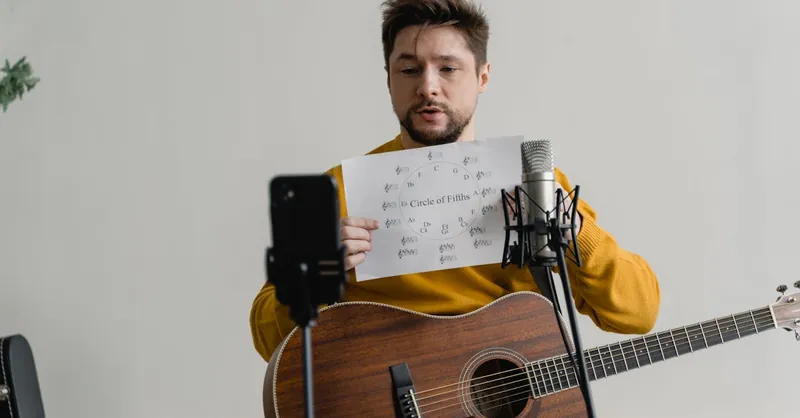
Image courtesy of Tima Miroshnichenko
Putting Theory into Practice: Simple Songs and Exercises for Guitar and Piano
After learning the core concepts of music theory—from notes and scales to intervals and chords—it's time to put theory into practice by playing simple songs and exercises that reinforce what you've learned. Applying theory directly to your guitar or piano playing helps solidify ideas, builds muscle memory, and makes the learning process enjoyable and rewarding.
Beginner-Friendly Exercises to Build Finger Strength and Familiarity
Start with basic exercises that incorporate major and minor scales, simple chord shapes, and rhythmic patterns:
- Major Scale Runs:
- On piano, play the C major scale ascending and descending slowly with your right hand, focusing on smooth finger transitions.
-
On guitar, practice the C major scale starting from the 3rd fret of the 5th string, using a standard fingering pattern.
-
Chord Switching Drills:
- Practice moving between easy chords such as C major, G major, and A minor on guitar, aiming for clean sound and steady rhythm.
-
On piano, play triads of C major, A minor, and F major, transitioning smoothly between chords with your right hand.
-
Simple Rhythmic Strumming and Playing:
- On guitar, strum a 4/4 pattern playing quarter note downstrokes on each beat, gradually adding eighth-note upstrokes for variety.
- On piano, clap or tap out 4/4 rhythms while playing matching chord progressions, integrating rests for rhythmic precision.
Example Songs to Reinforce Music Theory Knowledge
Playing recognizable, easy songs is a motivating way to see theory in action. These songs rely mostly on major and minor chords and simple rhythms, making them perfect for beginners:
-
“Ode to Joy” (Beethoven) – Melody in C Major:
This simple melody is ideal for practicing scales and note reading on both piano and guitar (played on a single string or using simple fingerpicking). -
“Knockin’ on Heaven’s Door” (Bob Dylan) – Chord Progressions:
Uses a repetitive four-chord progression (G - D - Am - C), great for practicing chord changes and strumming patterns on guitar or chord voicing on piano. -
“Let It Be” (The Beatles) – Basic Chord Accompaniment:
In the key of C major, this song uses common chords like C, G, Am, and F, excellent for practicing playing in time and understanding song structure.
Incorporating Theory into Practice Sessions
- Translate Theory to Your Instrument: As you play scales or chords, say the note names or intervals out loud to reinforce your understanding.
- Use a Metronome: Keeping a steady tempo helps internalize rhythms and develop timing crucial for ensemble playing.
- Record Yourself: Listening back can reveal intonation, timing, and smoothness of chord transitions to guide your next practice steps.
- Improvise Simply: Using the major or minor scale, try creating short melodies on your instrument, experimenting with intervals and rhythms you've learned.
By regularly working through these exercises and songs, you’ll bridge the gap between music theory and practical playing. This approach not only strengthens your skills on guitar and piano but also builds confidence and enjoyment as you hear theory come alive in your music.

Image courtesy of Pavel Danilyuk
Tips for Effective Practice: How to Make Music Theory Stick
Learning music theory is only half the battle; the other half is consistently applying what you learn through smart, focused practice. To make music theory truly stick and become an intuitive part of your guitar or piano playing, it’s essential to adopt effective practice habits that connect theory concepts directly with your instrument. Here are some proven strategies to help you internalize theory and improve faster:
1. Integrate Theory with Your Instrument Daily
- When you learn a new concept—like a scale, chord, or interval—immediately practice it on your guitar or piano instead of just reading about it.
- Use your instrument to name notes aloud, identify intervals, or figure out chord tones, which reinforces your theoretical knowledge through active engagement.
- Create simple exercises that combine theory ideas with playing, such as playing a scale while naming each note’s interval or constructing chords from scale degrees and hearing how they sound.
2. Prioritize Ear Training Alongside Visual Learning
- Developing your musical ear is crucial for recognizing intervals, chords, and rhythms without relying solely on sheet music.
- Practice listening and identifying sounds by playing intervals and chords on your guitar or piano and training yourself to name them by ear.
- Use online ear training apps or simple drills like singing scale degrees or clapping rhythms to strengthen your aural skills, which makes reading and improvising much easier.
3. Use Repetition and Consistency to Build Muscle Memory
- Regular, short practice sessions (15-30 minutes daily) focused on music theory applications help solidify your knowledge far better than infrequent, lengthy sessions.
- Repeatedly practicing chord transitions, scale patterns, and rhythm exercises develops the muscle memory necessary for smooth, confident playing.
- Incorporate a metronome in your practice to maintain steady timing while applying theory concepts, reinforcing precision in both theory and technique.
4. Apply Theory in Real Musical Contexts
- Try learning simple songs or backing tracks where you can apply scales, chords, and rhythmic patterns you’ve studied. This contextual learning makes theory relatable and fun.
- Improvise using the scales and chord tones you know, experimenting with different rhythms and intervals to connect theory to expressive playing.
- Take note of songs’ chord progressions and keys to understand how theory guides songwriting, which will deepen your overall musicianship.
By strategically combining ear training, hands-on practice, and consistent repetition, you’ll transform abstract music theory into practical skills that enhance your guitar and piano playing. This approach not only reinforces theory concepts but also fosters a natural, confident feel for music that will accelerate your progress as a beginner musician.

Image courtesy of Pavel Danilyuk
Recommended Resources and Next Steps: Apps, Books, and Online Courses to Deepen Your Music Theory Knowledge
Now that you’ve built a solid foundation in music theory basics for guitar and piano, it’s time to expand your understanding with trusted resources that offer structured learning paths and interactive practice. Whether you prefer learning on-the-go with apps, diving into detailed explanations in books, or following step-by-step video courses, these tools will help you advance beyond the fundamentals and develop your musicianship with confidence.
Top Apps for Learning Music Theory and Instrument Practice
- Tenuto – A highly rated app for practicing note recognition, intervals, chords, and rhythms with customizable exercises, perfect for beginners who want to train their ear and reading skills simultaneously.
- Yousician – Provides guided lessons and real-time feedback for guitar and piano players, combining music theory with practical playing exercises and popular songs.
- Complete Music Reading Trainer – Focuses on reading both treble and bass clefs, ideal for piano learners who want to strengthen their sight-reading skills quickly.
- Metronome apps (such as Pro Metronome or Soundbrenner) – Essential for mastering rhythm, timing, and keeping steady beats during practice.
Recommended Books for Structured Music Theory Learning
For a more comprehensive and progressive approach, consider the acclaimed “Music Theory for Guitarists and Pianists” by Tom Kolb. This book is designed especially for beginners, with clear explanations, exercises, and diagrams tailored to both instruments. It covers everything from note reading and scales to chord construction and the circle of fifths, making it a perfect next step to deepen your theory knowledge and application. Other beginner-friendly books include:
- “Hal Leonard Guitar Method” – Combines technique, theory, and song learning for guitarists.
- “Alfred’s Basic Adult Piano Course” – A widely used piano method integrating theory and performance.
Online Courses and Tutorials to Accelerate Your Learning
- Musictheory.net – Free interactive lessons and exercises with clear, beginner-friendly explanations.
- Coursera’s “Fundamentals of Music Theory” by the University of Edinburgh – A comprehensive online course covering essential concepts with quizzes and assignments.
- JustinGuitar and PianoLessonsOnline.net – Video tutorials that mix theory with real instrument demonstrations, ideal for practical learning.
- Udemy and Skillshare – Offer various paid and free courses specifically focused on guitar and piano theory, scales, and chord construction.
Next Steps to Maximize Your Progress
- Combine multiple resource types (apps, books, and video lessons) to reinforce learning through different modes.
- Set specific goals, such as mastering one scale, chord type, or rhythm pattern each week.
- Regularly revisit theory topics while applying them on your guitar or piano to connect abstract concepts with practical playing.
- Join online forums or social media groups devoted to beginner musicians for community support, tips, and song-sharing ideas.
By utilizing these recommended resources and continuing your practice with clear goals, you’ll steadily move from beginner to intermediate levels in music theory and instrumental skill. This ongoing journey will empower you to unlock new songs, improvise creatively, and enjoy playing guitar and piano with deeper musical insight.
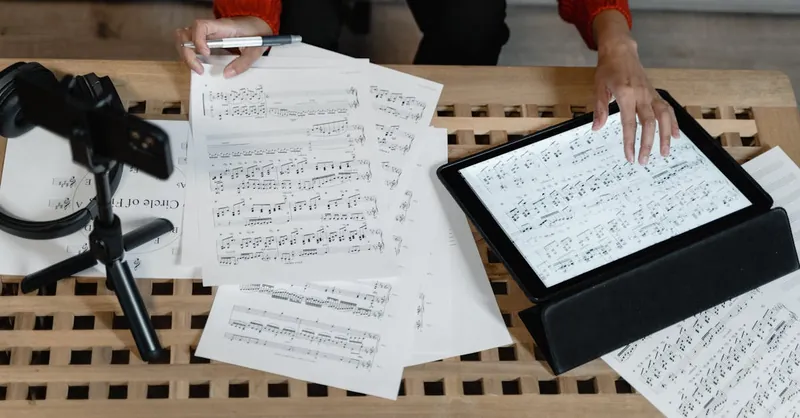
Image courtesy of Tima Miroshnichenko
